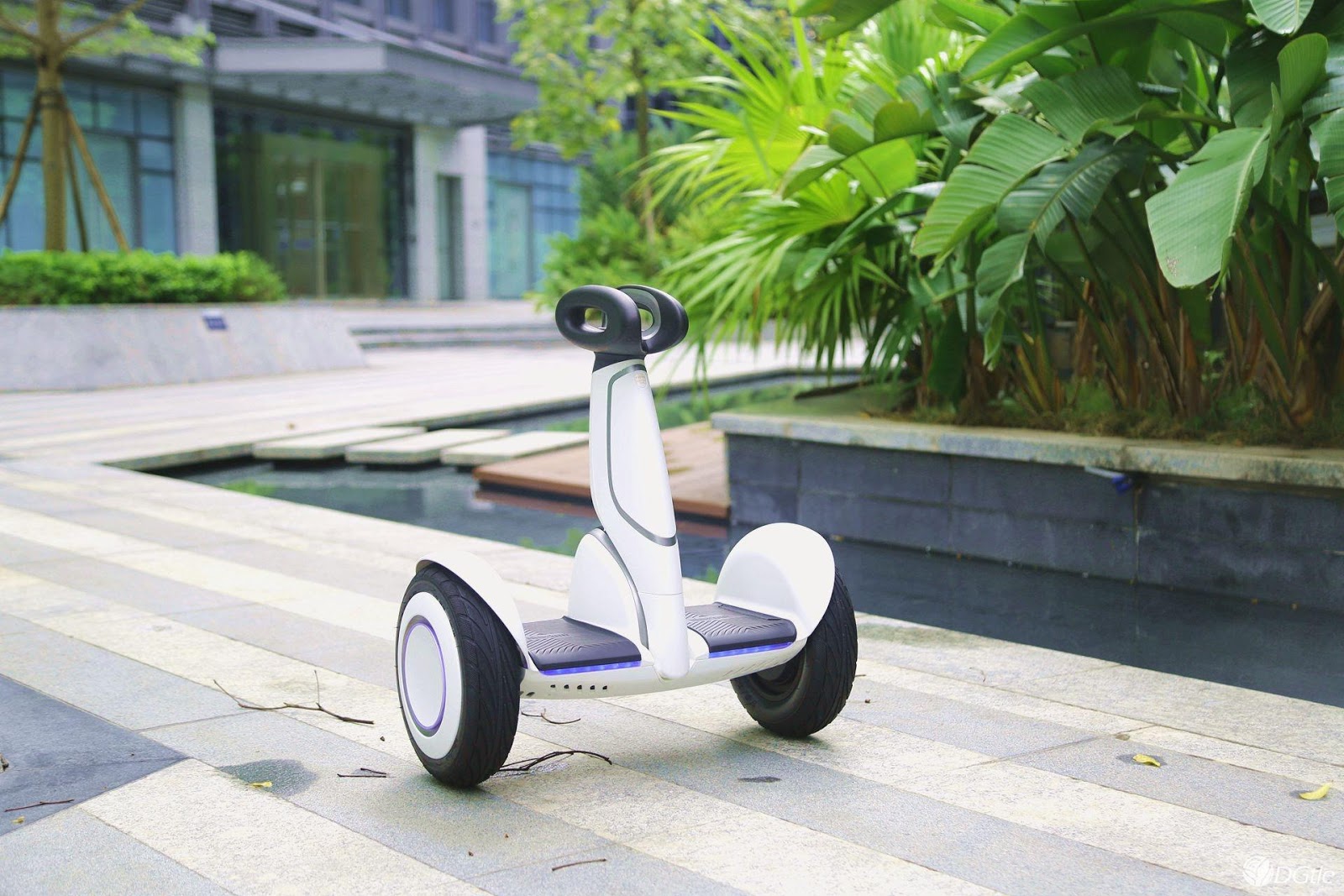By: Iris An
It is quite common in Nashville to see people on scooters everywhere, a lot of whom are Vandy students riding to their classes, parties, or a movie. In front of Stevenson, Kissam, and the Central Library, white BIRD and black LYFT are parked together, waiting for someone’s phone to scan their codes.
In October 29, 2020, a most uncommon yet adorable scene appeared on the Shanghai Stock Exchange listing ceremony: a small delivery robot wobbled to the front of the bell, pulled out a mallet from the storage box, stopped and measured for a few seconds, and then, without hesitation, it aimed at the center of the bell, and rang.
The little robot is S2, a Segway DeliveryBot who was ringing the bell for his creator: Ninebot, China’s sought-after startup in the micro-mobility industry. In the first seconds of the opening, the company’s share price jumped 74% and market capitalization reached $30 billion at one point.
But how is this related to our Nashville scooters?
Well, if you take a closer look at a scooter body, you will find a label on it, says “Powered by Segway.”
Segway, or Segway-Ninebot, refers to the Chinese tech company that just sought its IPO in Oct. 2020, who provided 80% of all US scooters and ranked first in market share in Segway industry every year from when the ranking of Segway market share came out.
Founded in Beijing in 2010, Ninebot took 10 years to grow from a 8-person lab in the basement to a dominating international player. Somehow, this sounds like one of the Wall Street investors’ favorite entrepreneurial stories. But is this real? How can a 5-year-old startup acquire Segway, the 16-year-old leader of self-balancing personal transportation devices, and continue to thrive in the US, EU, and Southeast Asia?
In this article, I try to answer the following questions:
- What is the self-balancing personal transportation device market, and where did Segway go wrong?
- What explains Ninebot’s rapid growth as a new entrer in the market? What differs this Chinese startup from the US leader company Segway?
- What helps a Segway maker to replicate its success as a scooter producer?
- What are the risks and limitations for Ninebot’s model? What’s the next step?
1) A question that Segway didn’t answer: Who are the target customers?
Segway was founded in 1999 and is the ancestor of the two-wheeled motorized vehicle — so ancestral that Segway the self-made word itself in English is a synonym for these devices.
But it may have been introduced too early for its time. A stereotype — that Segway riders were cool and lazy, that they should just walk — rooted in the minds of its potential customers, who would give the device a big “wow” and then turn away from it. Meanwhile, in popular portrayals in movies and TV, Segway becomes the preferred mode of transportation for goofy mall cop Paul Blart and for underachiever brother Gob in “Arrested Development.”
To make things worse, contrary to what this cool impression, Segway’s actual product was the opposite of portability and convenience. As you can see from the previous photo, the initial Segway was very different from today’s products, with wide and tall tires, large pedals, and a hand-held steering wheel: this was the only way to make the vehicle maneuverable and stable. Unfortunately, the cost was huge. The lightest household version weighed 32 kilograms, the handrail was half a person’s height, and the wheels covered half a meter square.
In the founder’s description, consumers can easily pack it into the trunk of their car for easy last-mile trips to the supermarket or park, etc. But in fact, every slightly narrower aisle was enough to users a headache, not to mention moving or traveling with it.
Segway’s discouraging weight and size brought another problem: its expensiveness.
In 2001, a cheapest Segway cost $4,000, while Segway for business was priced $8,000. Countless consumers rallied around this cool, new and disruptive product, raved about it, and then turned around to pay the same price for a used car.
With a transportation device that eclipsed the advantages of bicycle, motorbike, and vehicles, Segway tried to sell it to every user profile it could think of, so it created a behemoth that combined travel, cargo, and operational functions. It was too heavy for the hipster geeks, too expensive for the elderly and commuters, too unportable for travelers…
As you have probably realized by now, there was a crucial question but failed to answer by Segway: What is the target market?
Nobody inherently needed a Segway. Segway failed because it did not focus on any one application strong enough to enter a single market segment and to create the previously non-existed demand. As a Forbes article suggested in 2015, “Selling 100 Segways to 20 different uses was an inherently bad decision. What Segway needed to do was sell 100 units to a single, or at most 2, applications.”
If anything can make things worse, the last straw that brought Segway down was safety issues.
For a new product that is being introduced for the first time, safety is the primary concern. But what should be a basic issue nearly destroyed Segway’s public image. A disturbing list of celebrities’ Segway fails includes the 200 metres’ world champion Usain Bolt, US President George Bush, the talk show host Ellen DeGeneres, and even the owner of the Segway company Jimi Heselden.
Less than a year after buying the company from its founder, Segway’s then-owner rode a Segway off a cliff in September 2010, adding a horrible black humor in the company’s history. The police’s investigation, which concluded that the main reason was the Segway losing control, casted another cloud over the product’s reputation.
2) Ninebot: Redefining the product from transportation device to a high-tech toy.
When the initial product was introduced in 2001, Segway’s inventors called it “a disruptive innovation like a car to the carriage,” claiming that Segway’s annual sales would bottom out at 40,000 and hit 100,000. In the end, the company sold 30,000 units until 2007, which became one of the public ridicule in the U.S. media.
It was just around the year 2007, when an unknown Asian company set its eyes on Segway’s market.
The two founders of Ninebot, Gao Lufeng and Wang Ye who are both from Beihang Mechanical Engineering and Automation department, initially started the company to make robots. But back then, robots were too ahead of their time, and Segway seemed popular after its first appearance at the 2008 Beijing Olympics. The two graduates soon realized that the market of this two-wheeled motorized vehicle was highly monopolized, and that the only dominator struggling with poor sales and safety concerns. They switched their focus to these transportation devices instead of walking robots — anyway, in terms of self-balancing, the technology part was very similar.
Contrary to what Segway had done, Ninebot found a simple purpose to their product from the beginning: a toy. Rather than trying to sell Segways to everyone, Ninebot’s earliest balancing transporters only targeted celebrities, clubs, and other niche groups pursuing fashion.
They were very clear about what they wanted. Compared with Segway, Ninebot changed the wheel pedals all to a smaller size, sacrificing stability to make their transporters light and flexible. Because of their smaller size and less materials needed, the cost was also reduced.
In 2013, Ninebot launched their first personal transporters, weighed one-fourth of their American competitors’ and priced at only RMB10,000 (about $1545), which sold more than 20,000 units in the same year — far surpassing Segway. After seeing all the commercialized Segways around the world, the investors of Sequoia appreciated Ninebot’s vision, “They even knew better than Segway about what Segway should be made into.”
In 2014, the startup won more than RMB200 million revenue and a net profit of RMB 40 to 50 million in China. It was time to grow and to expand its market, but to where?
The domestic market didn’t seem promising. Ninebot encountered the same price issue as Segway: Although only 1/3 or 1/4 of the price of its American competitors, RMB10,000 was unaffordable for most households in China in 2014, and to break out from the current market segment was almost impossible. To keep developing, Ninebot could only go abroad.
But in the US market, Segway has been operating for more than a decade, registering more than four hundred patents from basic techniques to applications in the European and American markets. In September 2014, Segway filed a complaint with the U.S. International Trade Center (ITC) against Ninebot and a dozen other manufacturers, claiming patent and trademark infringement and requesting for general exclusion order and permanent cease and desist orders — which will basically lock Ninebot back into China.
“As if a company applied for a car patent of four wheels plus a sofa,” lamented Wang Ye, the founder of Ninebot, in recalling this experience, “such a patent threshold was simply insurmountable.”
It appears Ninebot was blocked both in the domestic and foreign market.
In the fall of 2014, when Segway was filing its complaint, Gao Lufeng paid its first visit to Lei Jun, and partnered with the latter’s Xiaomi Corporation, a Chinese multinational electronics company who offers smartphones and accessories at a lower price than other giant smartphone makers. To lower the price and broaden the domestic market, Lei advised Gao to transfer their product once again from a high-tech toy to industrial products. With Lei Jun’s help, Ninebot could not only use Xiaomi’s supply chain, but also received support from venture capital, including Sequoia China, which had invested in Xiaomi, and Shunwei Capital, founded by Lei Jun himself.
A year later, Xiaomi launched Ninebot mini, a two-wheeled Segway features a maximum speed of 16km/h (3.7 mph) and at a price of RMB 1999 ($297) — a classic use of “Xiaomi” pricing strategy. In two months, Xiaomi’s online sales platform sold 100,000 Ninebot mini, exceeding Segway’s ten-year cumulative sales.
Facing Segway’s complaint, Ninebot sought for a strategic partnership to license each other’s channels to sell their products. The two companies were very complementary: Ninebot is consumer-oriented, stylish and cheap, while Segway is more expensive and business-oriented with a strong reputation in police and security companies. However, when the Chinese team finally found an email address of Segway, their email was ignored and the other side didn’t show much interest. “The gap between Ninebot and Segway felt much farther than the distance between Beijing and New Hampshire,” said Zhao Zhongwei, the OOC of Ninebot.
Unexpectedly, Summit Strategic Investments, who bought Segway after its first owner died ironically and tragically of a Segway crash, offered an acquisition deal.
In April 2015, Ninebot did something unprecedented in the history of 337 investigations: the defendant acquired the plaintiff in full. The strategic acquisition of Segway brought with it 400 patents, as well as manufacturers, employees, R&D technologies, research scientists, and a global market fully accessible for Ninebot. “If someday I get Alzheimer’s, I will forget everything, but not this moment,” said Zhao Zhongwei, the COO of Ninebot.
As the 337 investigation concluded in March 2016, the U.S. International Trade Commission (ITC) issued a General Exclusion Order to the defendant companies, prohibiting these infringing products in the U.S. during the patent period. Ninebot, which acquired Segway, became the plaintiff from defendant. Two months later, Nine filed a complaint against six U.S. companies in the name of Ninebot, accusing them of infringing on the trademark and other rights of its subsidiary, Segway; in August of the same year, it again requested the ITC to launch 337 investigations against a dozen companies from China, the United States, the Netherlands, and Turkey, same way as Segway did back then.
Back to 2015, among the companies under investigation, there were many who had stronger technology and better sales than Ninebot, but only Ninebot sought opportunities while responding to the lawsuit, and dared to take a step forward in the situation of being surrounded by counterparts both domestic and overseas, which finally made it the last winner.
3) From Segways to scooters: from a toy-maker to a manufacturer of transportation devices
The rise of scooters is essentially a process of conceptualizing Micromobility, which refers to a range of small, lightweight devices operating at speeds typically below 25 km/h (15 mph) and is ideal for trips up to 10 km. In July 2020, McKinsey predicted that that the micromobility industry would grow to a $300 billion to $500 billion market by 2030. Among various business segments within this broad concept, scooter is now the most popular and affordable option: easy enough to ride, cheap enough to product, and light enough to be implemented everywhere.
Companies in the “scooter war” and their financing scale
In 2018, a scooter war started from Santa Monica, where BIRD lunched its first scooters, and soon raged through the streets of San Francisco, Seattle, Boston and Nashville, followed by Paris, London, Zurich, etc.
Under the apparent brand names are the products of the Ninebot. According to the founder of Nine in 2018, four out of every five shared scooters in the European and American markets come from Ninebot. The earliest batch of scooters put on the market even directly took the retail end of Ninebot and Xiaomi to do the labeling process, so much so that the scooter brand BIRD was ironically printed with a cat’s head.
Ninebot’s real foresight lies in the fact that when peers were still selling electric scooters as children’s toys, Ninebot decided to look at the sub-set as potential transportation devices. When the competing scooter companies sought manufacturers, Ninebot’s electric scooters won orders from almost all players including BIRD, Uber, Spin (acquired by Ford), Lyft and Lime (invested by Uber and Google). “At that time, the resources of the entire company was ALL in scooters and invested 10 or 20 times more than our competitors,” recalled the founder Wang Ye, “As the first personal vehicles, among other toy-makers, our standard on product quality, safety, and durability were completely different.”
4) Limitations and future directions
There has always been an unresolved concern with electric scooters that has limited the prospects of this category.
San Diego, California, one of the birthplaces of BIRD, had been open to shared mobility until the end of 2018, when first a drunk woman flipped and fell critically ill on a BIRD, and then a young man riding a BIRD died after being hit by a car. Under the raging public outcry, the government introduced regulatory regulations in April 2019, and 3,700 electric scooters were impounded for parking violations just 3 months after they came into effect, nearly 500 users were fined heavily, which forced Uber to pull out of the city, and BIRD to significantly reduced its launch.
This is just one example of market contraction in Europe and the United States. In fact, many US cities introduced similar restrictions late in the year, and bans were introduced in Singapore, Montreal in Canada, and Copenhagen in Denmark. At the end of 2019, 223 cities in Europe and the US offered shared electric scooters, while by March 2020, this number had been reduced to 177.
At present, it seems that the dust has settled on the war of shared electric scooters, and most of the future demand will come from cyclical stock replacement. But Ninebot does stop at here: At the end of 2019, Nine held a new product launch with great fanfare to announce its entry into a traditional micromobility market: electric bicycle.
As the third electric two-wheeler produced by Ninebot, an electric bicycle is not a random choice. The company is aiming for the growing demand in India and Southeast Asia. The trend of new energy replacement is rising in Asia. Indonesia, rich in nickel, cobalt, manganese, and other battery materials, has set a short-term goal of 2025 to complete the replacement of 20% of electric vehicles, and India has issued the aims of quadrupling renewable electricity capacity by 2030. However, the current situation of transportation in Southeast Asia and India determines the limited consumption of cars, so the replacement policy will mainly benefit electric motorcycles.
At the new product launch at the end of 2019, Ninebot launched five electric motorcycles and three electric bicycles, open up a gap with the market competitors with its keyless convenience, automatic locking, and black box hardware monitoring.
So this is Ninebot’s way to break through barriers. The technology, sales network, and marketing that has been polished for years in scooters and Segways are applied once again in electric motorcycle. Of courses, to enter a new field may not be as easy as transferring from robotics to Segways and from Segways to scooters, there will be new and more mature competitors, unfamiliar markets with different cultures and languages, and challenges from poor transportation conditions in the Indian mountains and the Philippine islands. Ninebot’s opportunity and risk comes together, and it needs time to reveal whether the former “copycat” can truly grow to a global player.
“Here comes the golden age of micromobility, and here comes our chance,” says Gao Lufeng.




